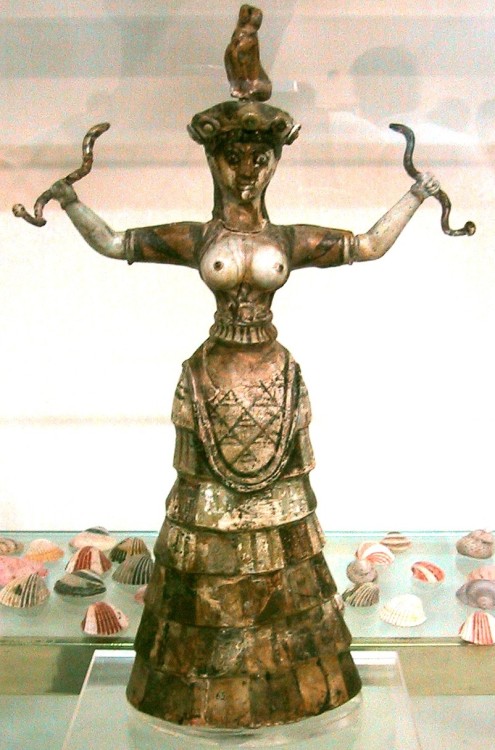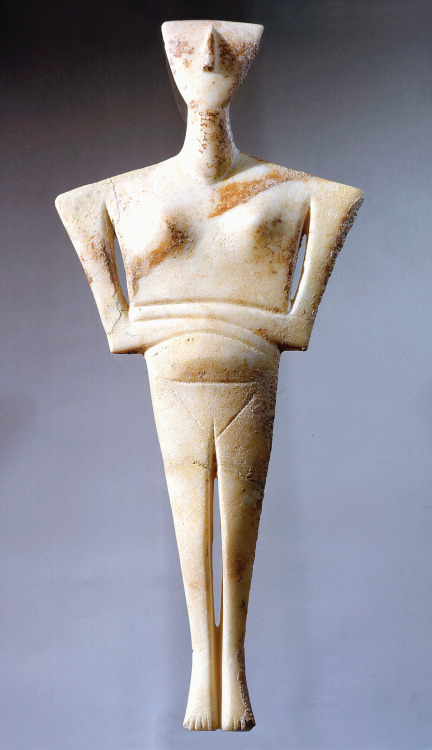#bronze age greece
Warrior Vase, Mycenae, Greece. 1200 BCE, Mycenaean.
- referred to as a krater; two handles on the side, was used to store and/or serve wine. more for ceremonial/decorative use.
- depicts a woman (left hand side). raised arm, bidding farewell to the soldiers. only one to show emotion.
- battle very significant with ancient greece.
- soldiers show no emotion, but they’re soldiers. supposed to be stoic marching into battle. features do not differ; same figure repeated. certain anonymity to being a soldier. promotes sense of unity amongst the military, one unitary body
Post link
Lion Gate, Mycenae, Greece. 1300 BCE. Mycenaean.
- limestone relief panel; 9’ 6" high.
- lots of fortresses in Mycenaean architecture; due to it’s location in the gulf, under threat of attack. very vulnerable; reachable through sea and land
- gate protected by two lionesses. more fierce than their male counterparts because they protect their young and do all the hunting
- post and lintel technique. two posts to support the bar above to create the archway
- largest sculpture from Mycenae.
Post link
Marine style octopus jar, Palikastro (Crete), Greece. 1500 BCE. Minoan.
- 11" high
- pottery a hallmark of prehistoric art
- minoans responsibile for creating the potter’s wheel. allows for greater height, thinness, and gracefulness of form.
- last purely minoan style known
- marine style - dark figure on light round vessel. two toned and perfect combination of form and function.
- horror vacui - the fear of open space. very crowded with design elements.
Post link
Snake Goddess from the palace at Knossos, Crete, Greece. 1600 BCE, Minoan.
- faience pottery; fired at low temperature. quartz with glaze. measured 1’ 1 ½" high.
- prominent breasts, emphasized by pinched waist. white body, red face. wide eyes.
- perhaps not a goddess, but rather a priestess/religious attendant
- why were women associated with religion? by nature, thought of as motherly. literally not the same person every day. natural cycles made women earthly, connected with the earth.natural morality. guardians of the temple meant they were guardians of morality. association with animals
- snakes beneficial to greek civilization. ancient greece was prone to earth quakes. snakes were considered a key indicator that earth quakes were coming. considered revered for their ability to detect disaster. represent rebirth: shedding of skin metaphorical for a new life. stand their ground when threatened; also considered guardian
- rabbit on her head
- seen as goddess because of her dominance over these animals. must have a lot of confidence to hold snakes like she is
- errant pose signifies openness and humility.
Post link
Bull-leaping, from the palace at Knossos, Crete, Greece. 1450 - 1400 BCE. Minoan.
- one of the earliest known frescos in Greece. measures 2’ 8" higher, including border
- depicts man leaping onto the bull with two women on either side. the women are painted white, and the man has dark skin. women participating.
- from the minotaur, bulls are perhaps a very sacred animal and a central theme in minoan society.
- dark batches are the original portions of the fresco; the rest has been restored.
- elongated and stylized bodies. pinched waist, large eyes, curled hair, and prominent profile.
- more natural appearance, but not a composite view (like egyptian style)
- don’t know if this is a sport or religious ritual; there is a mythical story about dancing with the great bull, perhaps connected
Post link
Palace of Knossos, Crete, Greece. 1400 - 1200BCE, Minoan.
- comes from the golden age of Crete.
- included residential suite for king, eremonial rooms for pageants and games.
- legendary home of King Minos. belief that this city was founded by Theseus , who slayed the minotaur. The minotaur would be fed seven people a year; Theseus volunteered to kill the monster and defeated him with the help of Ariadne, the king’s daughter, who gave him a thread to navigate the labyrinth.
- also had store rooms and work rooms
- had a theater, the forerunner to ancient greek theater. complex in it’s elevation and plan.
- had a system of terra-cotta pipes, earliest form of plumbing and running water
Post link
Figurine of a woman, Syros (Cyclades), Greece. 2500 - 2300 BCE. Cycladic.
- marble; 1'6" high
- clearly a woman; has pubic triangle and breasts
- very flat, almost 2d. geometric and abstract. made up compositionally of triangles.
- found in a grave lying with the deceased. could be associated with death, due to the figure assuming the rigid position of a dead person.
- very anonymous; more of an idea than a portrait because it doesn’t have a unique identity
- might be a fertility goddess; there’s debate over whether or not she’s supposed to be pregnant because of her rounded belly and arms folded over the stomach
- used to be painted with a pair of eyes and mouth, bracelet, and necklace. most likely the paint was cleaned off in the 19th century to achieve the pure white marble aesthetic of the contemporary age.
Post link
Early Greek society is difficult to understand because there is no written record. Like Prehistory, the only information about early Greek society comes from art and architecture, but even that’s out of context. Early archaeology destroyed the integrity of certain cites and graves, and artifacts became collectables. Early Cycladic and Minoan style looks very modern because they were very simple and easy to recreate.
The art itself was not rediscovered until the 19th century. IT was found because rich businessmen turned archeologists wanted tangible proof that these civilizations. This was fueled by neoclassicism, a movement of art during the 19th century. As government systems moved toward democracy, people became obsessed with greek culture, plundering sites for jewerly, death masks, cps, weapons, and undecipherable scripts. Key figures include Heinrich Schliemann, Lord Elgin, and Sir Arthur Evans.
There are three categories of art in this period of history: Cycladic, Minoan, and Mycenean.







